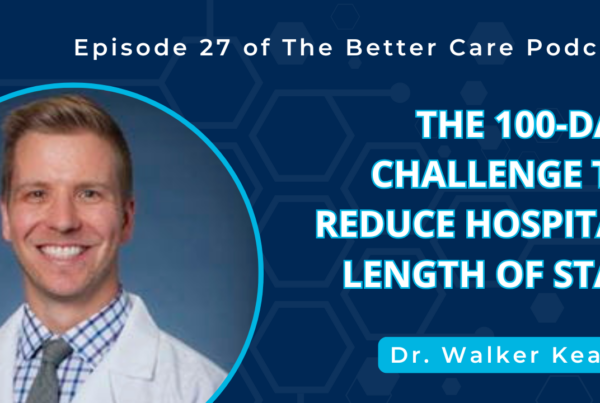Q&A with Andrea Ortman, VP of Inpatient Care Management and Post-Acute Care at Geisinger
Carol Howard interviewed Andrea Ortman, VP of Inpatient Care Management and Post-Acute Care at Geisinger, for the first episode of The Better Care Podcast – Creating a Modern UR Department.
Andrea discussed the challenges Utilization Review departments face today and provided her perspective on hot topics across the industry. Here is Andrea’s take on 8 of the most common questions being asked in UR today:
Should UR report to the CFO or CMO/CNO?
“Well, this is a tricky question… UR has clinical ramifications, but it’s a financial feature. If a patient is in an inpatient status, we can use skilled nursing facilities where required. But plain and simple, you’re working with payers and finances, so it’s a financial component.”
Should UR and Case Management be combined or have two separate roles?
“Two separate roles. There’s a collaboration between UR and Case Management. You do that by having all authorizations go through UR, and if a patient needs authorization to leave that hospital, that care manager needs it, so you need to communicate back and forth. The UR function is constantly communicating with the payers, so they need to be free and clear to work with that payer and not be burdened by a patient conversation – that’s the care manager’s job.”
Internal or external physician advisor team?
“Our physician advisors are internal, and they are dedicated positions. A few years back, we had a handful of external physician advisors who never received formal training, and we found that it’s ineffective when you’re trying to fight a payer. Peer-to-peer reviews take time and scheduling when your physician advisor team is external.
We now have dedicated reviewers who are expertly trained and assigned to individual campuses. We’re teaching them the nitty-gritty details of what a payer offers us and what they will ask in a peer-to-peer review. They’re experts in this space. They only manage a handful of cases, but when they get those cases in their queue, it’s the expectation that they make every opportunity available to appeal that case.”
How do you handle payer audits of short stays?
“I will tell you that historical cases extending beyond the current program, where the physician advisors review those short cases and enter additional documentation, are still a bear. You’re querying a chart independently, trying to find information to support that stay despite having already done that work for the payer. In many instances, you’re not going to achieve approval for that payment, which will be a takeback.
With the new processes we’ve established over the past few years, which include our physician advisors looking at that short stay and adding documentation, and AdmissionCare, which has the criteria embedded in the medical record, we have the tools to fight that fight around the short stays. Make sure you have concise information you can pull at any time to support your payment.”
Will inpatient and observation status ever go away?
“No. We’ll manage it differently, but it’s the way to control costs. I think there are going to be fewer patients that end up in observation in healthcare systems simply because there’s a crunch on bed needs. We’re experiencing that nationally, so only the sickest of the sick patients are going to get there, but I don’t think that the actual statuses will go away.”
How do you stay compliant with the CMS Two-Midnight Rule?
“You must have your medical documentation in order. You must ensure the physician cosign is on the chart, so the physician still has the autonomy to do as the physician decides. But providers need to figure out what to do, and they’re often just following UR recommendations in most instances.”
How can we get physicians more involved in UR?
“It starts with transparency. You need to help the physicians understand the criteria and what that payer will be looking for because UR is a pain point for them. 100% of providers, no matter what their practice, will deal with utilization review at some point in time, so it’s an opportunity for education for all providers.”
What KPIs do you report on?
“The UM team uses work queues to ensure work is completed and tasks are managed efficiently. We also have weekly and monthly reports that look at trends over time. It’s important to look at the percentage of your patients in observation and, of those in observation, how many are crossing two midnights. You need to pay close attention to those cases that cross two midnights. This patient may, in some instances, have a social scenario that requires admission, but if there is a medical reason, you better be working hard to upgrade that case.”
What is the biggest issue in UR Today?
“Staffing is the biggest issue, which is why you must leverage technology in every way you can. Have your team focus on meaningful work and find other ways to accomplish the tasks, such as notice of admission and notice of discharge. You don’t need a human to do those things. It’s all logic based. The key is to manage the staffing with your technology.”
How are you managing the battle between payers and providers?
“We’re leveraging our electronic health system and saying, ’Listen, payer, I’m going to give you an automated notification that your patient is receiving services in our hospital. I’m going to tell you the order that we’ve placed (meaning there’s been a dialogue between the UR reviewer and the providers, and we are confident that our status is appropriate), and we want you to come and query the chart. You look for the information that is most helpful to you.”
Listen to the full interview on The Better Care Podcast, available now on all major podcast apps!









